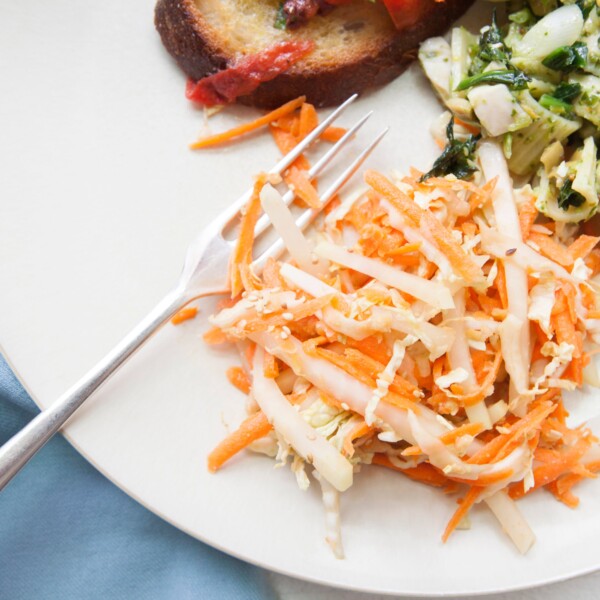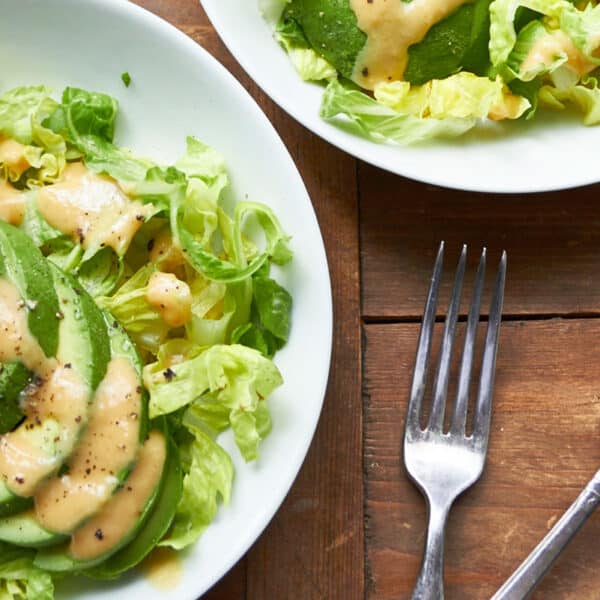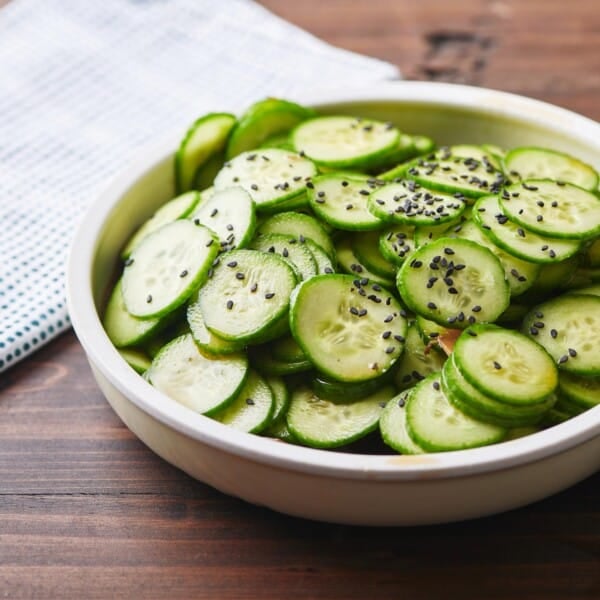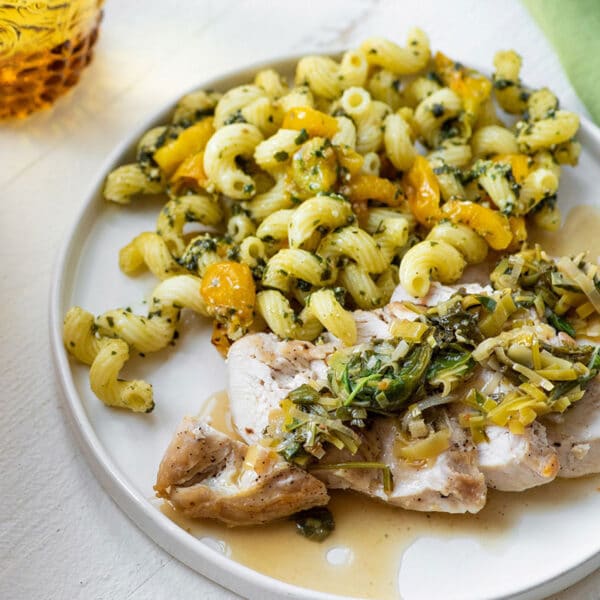Takikomi Gohan with Chicken
on Mar 23, 2024, Updated Nov 03, 2024
This post may contain affiliate links. Please read our disclosure policy.
This comforting Japanese chicken and rice dish is gentle but filled with umami flavors.
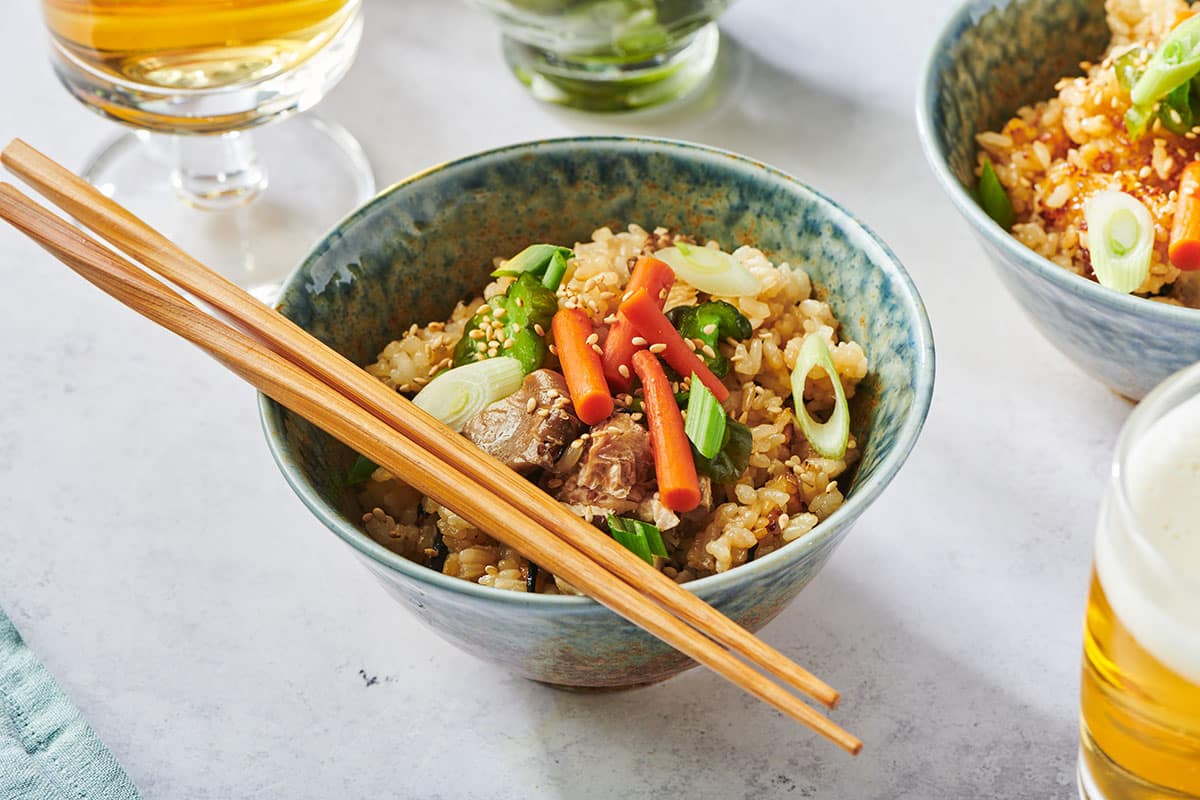
This classic Japanese rice dish is simply the epitome of comfort food. Takikomi Gohan or Taki Gomi Gohan means “clay pot mixed rice.” While a bowl of plain rice is delightful, this rice, with all of its umami flavors, is another level of heartening.
The recipe comes by way of my friend Risa, who is also the sensei and owner of the Japanese pottery studio I belong to in NYC. When I asked her what meals she cooks for herself regularly, simple and cozy, this was the first recipe she mentioned. I worked on it for months, brought it in for her to test, and finally, I think I have it.
By signing up, you agree to our Privacy Policy.
This is a version of takikomi made with chicken, but you can make it vegetarian or with salmon (that recipe coming soon!). I could eat this with a serving spoon. This recipe serves 4 if portions are moderate or 3 if portions are more generous.
What's In This Post?
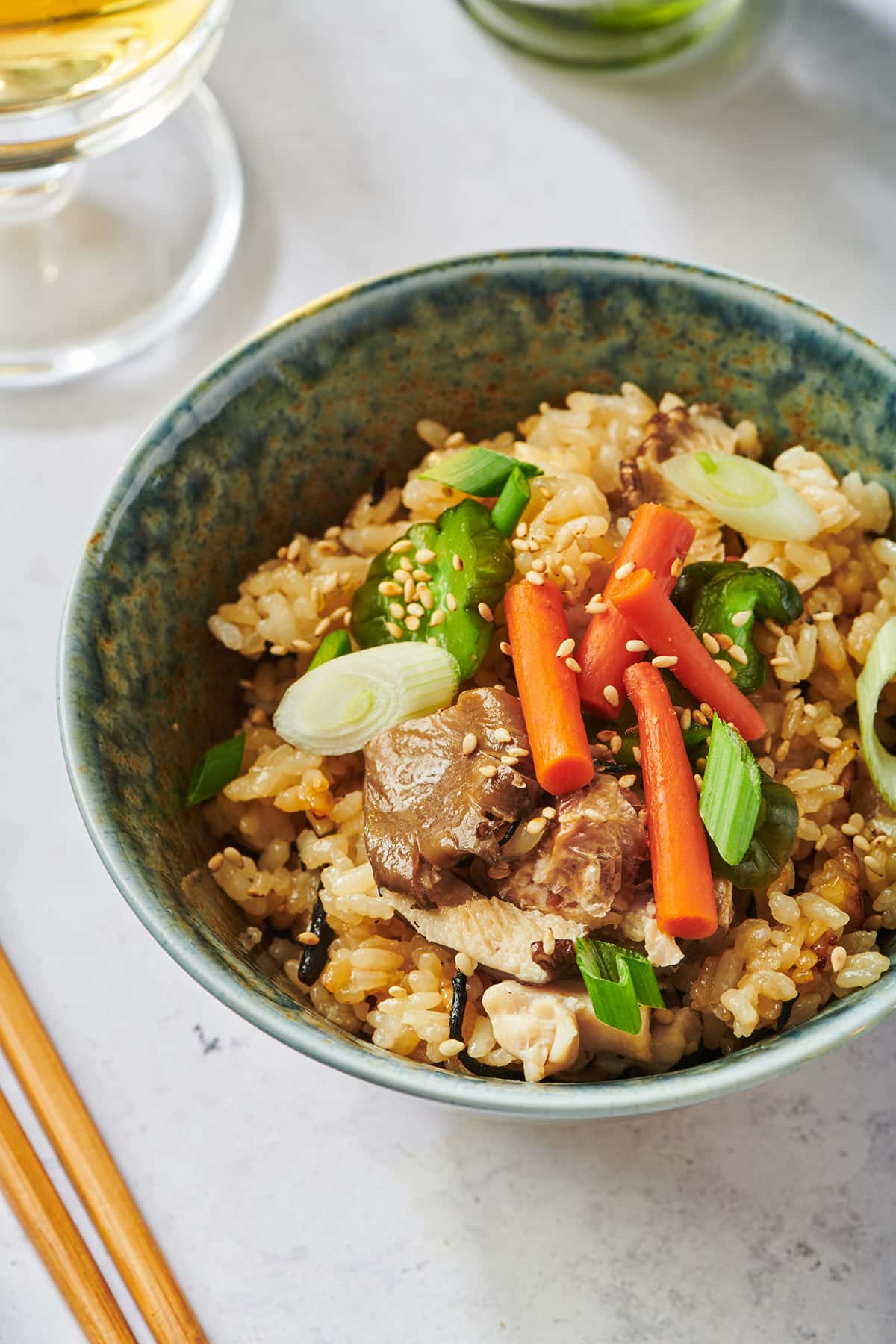
Takikomi Gohan with Chicken: This comforting Japanese rice dish is gentle but filled with umami flavors.
Japanese Cooking Flavors
All of the pottery folks at Togei (Risa’s studio) are a touch food-obsessed. Maybe we all make vessels to serve food in, so we think about food a lot? Maybe we think about food a lot, so we make vessels to serve them in? Whatever the causal relationship is, we are always discussing what we made and what we ate. So I get to pick up some very delicious tips, mostly to do with Asian cuisines.
Risa explained that the traditional flavor lines that run throughout Japanese cooking are based on the Japanese alphabet. Not all of these flavors will be used in every dish, but it’s kind of like the palette from which most Japanese cooking is created.
- Sa-satou – Sugar. In this case, mirin rice wine provides the sweetness. If you don’t have mirin, you can use a teaspoon of sugar.
- Shi-shio – Salt.
- Su- oso – Vinegar. In this dish, there is no vinegar, but the pickled vegetables used to garnish the rice provide a bit of that tangy tart flavor.
- Se-shoyu – Soy sauce.
- So-miso – Miso. Miso isn’t used here, but there is plenty of umami from the other ingredients.
Ingredients for Takikomi Gohan
For the rice:

- Dried shiitake mushrooms – See below for other options.
- Hijiki – Hijiki is a dried seaweed available at Asian grocery stores, or you can find hijiki online.
- Short-grain rice – Don’t try this with long-grain rice; you need Asian short-grain rice.
- Water
- Less sodium vegetable or chicken broth
- Kosher salt
- Soy sauce
- Sake – Rice wine, available at wine and liquor stores.
- Mirin – A sweet rice wine, also available at Asian markets, well-stocked grocery stores, and online.
- Bonito flakes – Called katsuobnushi in Japanese, these are flakes made from boiled, dried, smoked, and cured Skipjack fish. These are optional but really add depth of flavor. Bonito flakes are used in many Japanese dishes from soup stock to a garnish for cold tofu.
- Boneless chicken thighs – Thighs will stay juicier than breast meat.
- Carrot – Adds nice color, texture, and a bit of sweetness.
- Oyster and beech mushrooms – See below for other mushroom options.
To serve (optional):
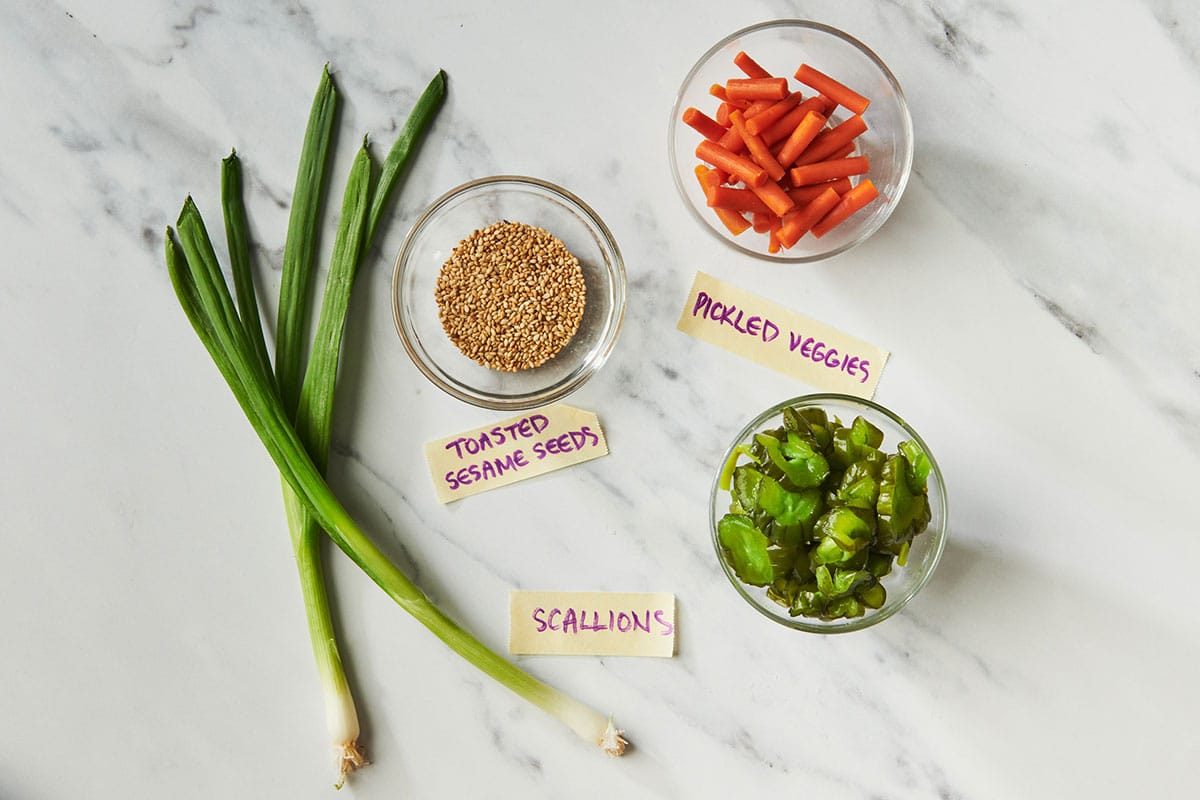
- Mitsuba leaves – A type of wild parsley, this herb is commonly used in Japanese food. Celery leaves or chervil makes a good substitute.
- Toasted sesame seeds – For a bit of spice, use wasabi sesame seeds.
- Sliced scallions
- Sliced or diced pickled vegetables – Plums, radishes, and cucumbers are good options.
How to Make Takikomi Gohan with Chicken
- Rehydrate the mushrooms and hijiki: Place the dried shiitake mushrooms in a small bowl and cover with hot water. Let it sit for 2 hours to 12. Place the hijiki in another small bowl and cover with hot water; let sit for 1 hour.
- Soak and season the rice: Rinse the rice in a fine mesh strainer until the water runs almost clear. Place the rice in a saucepan with a lid. Add the water, broth, salt, soy sauce, sake, mirin, and bonito flakes. Let soak for 20 to 30 minutes.
- Prepare the other ingredients: Meanwhile, dice the chicken, slice the carrots into matchsticks, and cut the oyster and beech mushrooms.

- Combine everything: Add the hijiki and any remaining soaking liquid to the pot (there should be about 1 to 2 tablespoons of liquid). Remove the soaked shiitake mushrooms from the liquid and slice them into a few pieces each. Pour about 2 tablespoons of the shiitake soaking liquid into the measuring cup. The total liquid should cover the rice by about 1/2 inch. Add the rehydrated shiitakes, chicken, carrots, and oyster mushrooms. Separate the beech mushrooms a bit, and lay them on top.
- Cook: Bring the liquid to a simmer over medium heat. Once it’s simmering, cover the pot, and continue to simmer, covered, for 15 minutes, adjusting the heat so it stays at a simmer but not a boil. Lower the heat if needed.
- Fluff the rice and rest: After 15 minutes, remove from the heat and let sit for 10 minutes without opening the lid. Fluff the rice, combining the ingredients evenly into the rice. Cover again, and let sit for 5 minutes, then fluff the rice once more.
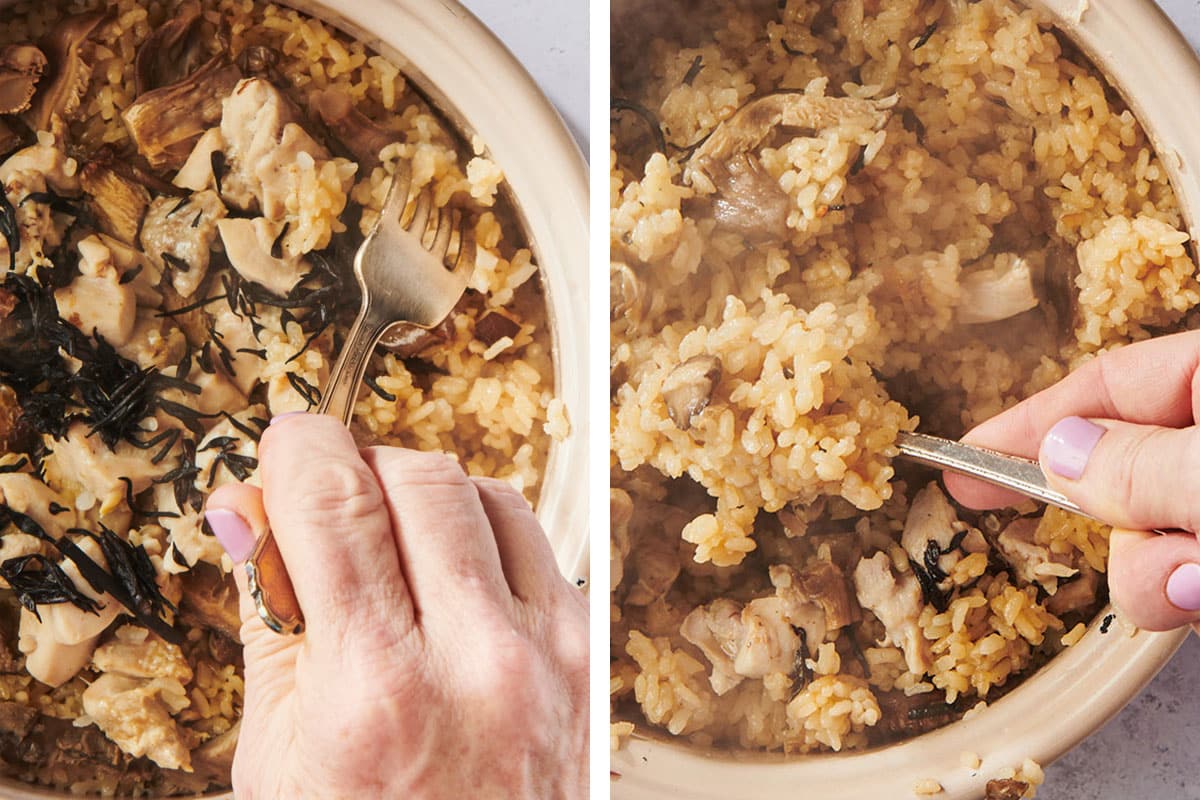
- Serve and garnish: Serve hot in bowls, sprinkled with scallions, sesame seeds, mitsuba leaves, and pickled veggies.
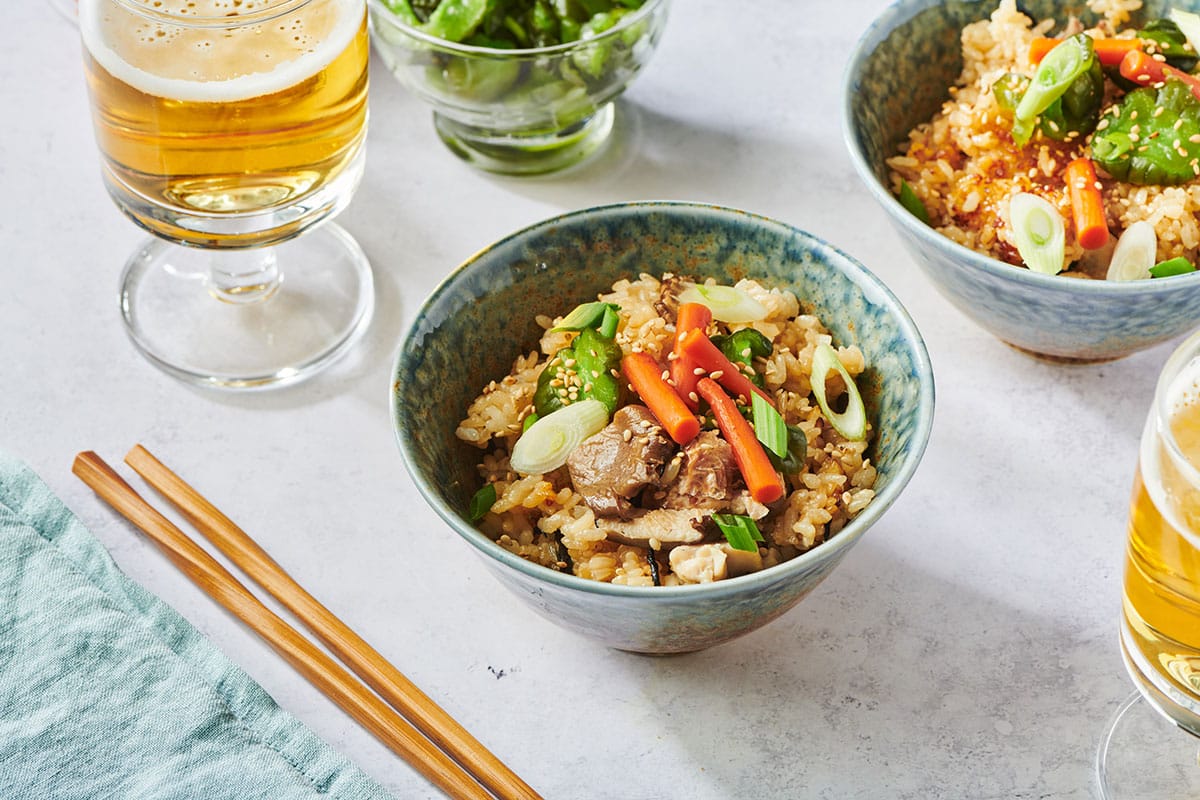
Substitutions and Tips for Making Takikomi Gohan
- Mitsuba is like a wild parsley. It is also used with Vietnamese spring rolls.
- Use the liquid from the rehydrated mushrooms and the hijiki to add flavor to the rice.
- The liquid used to cook the rice should be a diluted broth, not too strong.
You can also add a couple of teaspoons of dashi (made from powdered dashi mix or in a tea bag type) to flavor the cooking liquid. You can sprinkle in the powdered dashi when you add the bonito flakes. - Instead of oyster mushrooms, try Maitake mushrooms. You can also substitute enoki mushrooms for the beech mushrooms, though enoki are more delicate.
- Try dried wood ear mushrooms instead of the shiitakes. Risa says to avoid dried mushroom blends — they tend to take on each other’s smells and flavors, and each component loses its distinctive nature.
- Risa also says to use a glass pot if possible (what she grew up with). A clay pot is very traditional for making this dish, but I have had great success with a regular stainless steel pot.
- If you don’t have mirin, you can use a teaspoon of sugar.
- If you can’t find mitsuba, leave it out, or use celery leaves or chervil instead.
FAQs
The word takikomi means “boiled with” in Japanese, and gohan means “cooked rice.”
Yes, you can definitely cook takikomi gohan in a rice cooker. But, you might have to experiment a bit to find the perfect timing for your particular rice cooker.
Toppings for Taki Komi Gohan
This dish is wonderful without any toppings, but next level with them. Traditional toppings are sesame seeds, scallions, fresh ginger, pickles (umeboshi or pickled plums are a classic choice), shiso leaves, Mitsuba leaves (wild parsley), and shredded nori.
What to Serve With Takikomi Gohan and Chicken
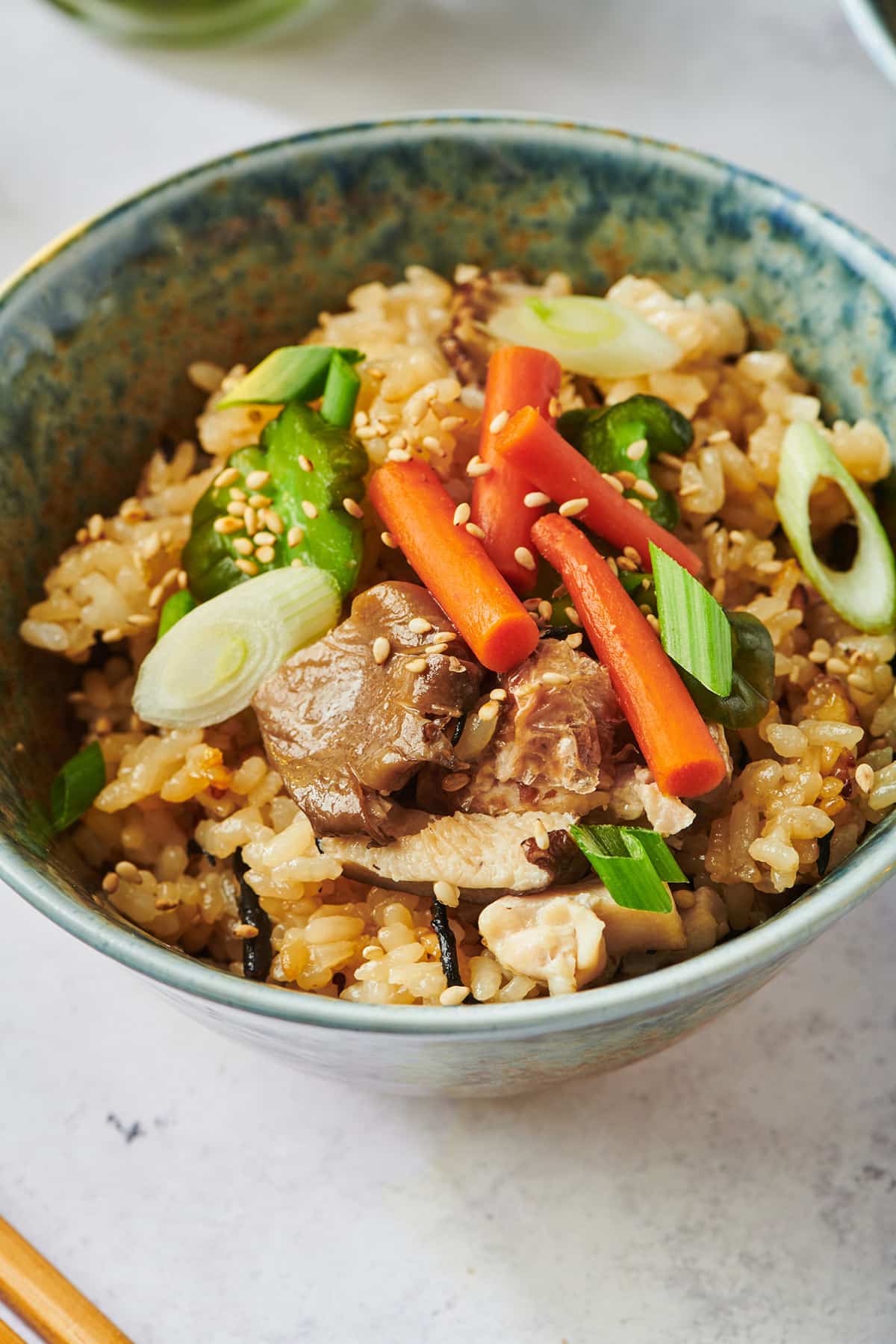
More Japanese-Inspired Recipes
- Chicken Yaki Udon
- Japanese Restaurant Salad Dressing
- Japanese Miso Eggplant
- Miso Black Cod
- Teriyaki Salmon
Pin this now to find it later
Pin It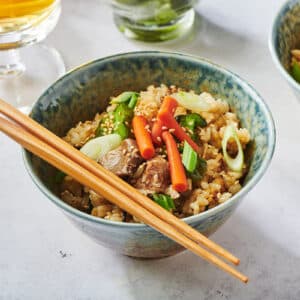
Takikomi Gohan with Chicken
Ingredients
- 2 to 3 dried shiitake mushrooms
- 1 to 2 tablespoons hijiki
- 1 ½ cups short-grain rice
- ¾ cup water
- ½ cup less-sodium vegetable or chicken broth
- ¾ teaspoon kosher salt
- 2 tablespoons soy sauce
- 1 to 2 tablespoons sake
- 1 to 2 tablespoons mirin
- 1 to 2 tablespoons crushed bonito flakes (optional)
- 2 boneless chicken thighs (about 12 ounces; trimmed of fat and diced)
- 1 carrot (diced or cut into matchsticks; about 1/2 cup)
- ¼ cup roughly chopped oyster mushrooms
- ½ (3 1/2- to 4-ounce) pack beech mushrooms (cut in half crosswise)
To Serve (Optional):
- Mitsuba leaves (wild parsley)
- Toasted sesame seeds (try wasabi sesame seeds)
- Sliced scallions
- Sliced or diced pickled vegetables (such as plums, radishes, or cucumbers)
Instructions
- Place the dried mushrooms in a small bowl and cover with hot water. Let it sit for at least 2 hours and up to 12. Place the hijiki in a small bowl and cover with hot water. Let sit for 1 hour.
- Rinse the rice in a fine mesh strainer until the water runs almost clear. Place the rice in a saucepan with a lid. Add the water, broth, salt, soy sauce, sake, mirin, and bonito flakes. Let soak for 20 to 30 minutes.
- Add the hijiki and any remaining soaking liquid to the pot (there should be about 1 to 2 tablespoons of liquid). Remove the soaked shiitake mushrooms from the liquid and slice them into a few pieces each. Pour about 2 tablespoons of the shiitake soaking liquid into the measuring cup, making best efforts to leave any bits of solids behind. The liquid should cover the rice by about 1/2 inch (see Note). Add the rehydrated sliced shiitakes, chicken, carrots, and oyster mushrooms. Separate the beech mushrooms a bit, and lay them on top.
- Bring the liquid to a simmer over medium heat. Once it’s simmering, cover the pot, and continue to simmer, covered, for 15 minutes, adjusting the heat so it stays at a simmer but not a boil. Lower the heat if the liquid starts to bubble too vigorously. After 15 minutes, remove from the heat, and let sit for 10 minutes without opening the lid. Lift the lid and fluff the rice, combining the ingredients evenly into the rice. Cover the pot again, and let sit for 5 minutes. Fluff the rice once more time.
- Serve in bowls, sprinkled with the scallions, sesame seeds, and mitsuba leaves if using, and serve hot.
